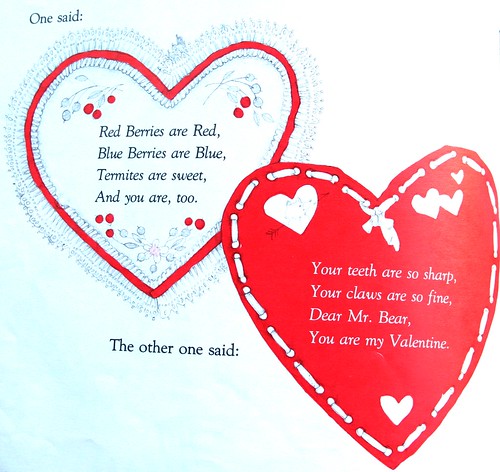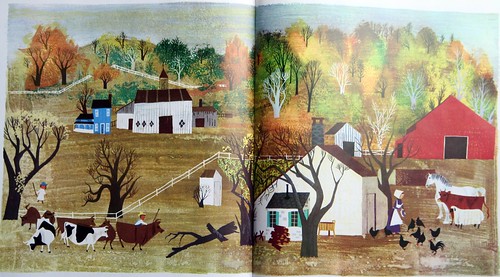Best Valentine’s Day Books for Young Children
Are you looking for a good Valentine’s Day story to share with your family? Good luck! I’ve found that by and large the pickings are pretty slim. I started writing this post of my favorite Valentine’s Day picture books more than a year ago, and it’s pretty much too late to be much use this year. But what the heck, right? I’ve done a lot of research to develop this list and I can assure you that many, many titles didn’t make my list. (Write me and I’ll give you my opinions about what to avoid.) As usual, I recommend steering clear of any holiday book from a movie or TV franchise.
Snowy Valentine, by David Peterson, 2011
I think this is my favorite of all the books in this list. Peterson is the author/illustrator of Mouse Guard comic book series, for those of you in the know. This is his first picture book. In it, Jasper bunny searches the forest for a Valentine’s Day gift for his wife Lilly. He looks to his neighbors for ideas, and considers knitting a gift, chocolate-covered flies, and wilted flowers. He narrowly escapes the fox’s soup pot! (This part could be unsettling for the youngest readers.) Over the course of his day, Jasper creates the best possible valentine for Lilly. The story and illustrations are compelling.
Henry in Love, by Peter McCarty, 2009
A simple, tender story about a first crush. Henry brings a blueberry muffin in his lunch. Henry likes Chloe very much; he really likes the way she does cartwheels. Chloe and Henry get to sit together at lunchtime, and he gives her his blueberry muffin. Good for the Kindergarten or first- or second-grade child.
Woof A Love Story, by Sarah Weeks, illustrated by Holly Berry, 2009
“A dog is a dog and a cat is a cat, and most of the time it’s as simple as that.” Dogs and cats are different, but it doesn’t stop the dog from falling in love with the cat. Dog tries and tries to say “I love you!” but unfortunately, they don’t speak the same language. Cat can’t understand him, until he finds the universal language of love that she can understand. The illustrations in this book are bold and vibrant.
Plant a Kiss, by Amy Krouse, illustrated by Peter H. Reynolds, 2011
A perfect choice for a toddler or preschooler. Its adorable illustrations and rhyming text are cute, and it’s pages are embossed, so there is a tactile element to the reading experience. The meaning is simple: Love grows!
Mouse and Mole Secret Valentine, by Wong Herbert Yee, 2013
Secret Valentine is a 40-page “chapter book” for early readers. If you like Frog and Toad books, you’ll probably like Yee’s Mouse and Mole books too. Together Mouse and Mole make valentines for all of their forest friends, and the text gently teaches simple valentine-making skills such as cutting hearts and applying glue and glitter and then tapping off excess glitter. Then Mouse and Mole deliver their valentines together and have lunch at a restaurant. Each wants to give a secret valentine to the other, and they visit the sweet shop and the flower shop for gifts. Then they attend a Valentine’s Day dance. This book shows an innocent romance for little readers or listeners.
One Zillion Valentines, by Frank Modell, 1981
This is a sweet story about two friends, Marvin and Milton. They learn that “Valentines aren’t just for girls. Valentines are for everybody,” and “If you don’t send any, you don’t get any,” and finally that you can make your own. They make valentines for everyone in the neighborhood, and they sell some, too. With the money they earn they buy some chocolate and end up giving it to each other. This is the only Valentine’s Day book I found that includes same-sex valentines.
The Valentine Bears, by Eve Bunting, illustrated by Jan Brett, 1983
Mr. and Mrs. Bear hibernate in the winter, but Mrs. Bear sets her alarm clock for February 14 to wake up and celebrate Valentine’s Day, even though it’s not spring yet. Mr. Bear sleeps on. She makes lots of preparations such as getting honey, beetles, and bugs. They celebrate together, and then go back to sleep till spring. The black, white, and red pictures in this book are charming, but not as lavish as many of Brett’s other works.
Pleasant Fieldmouse’s Valentine Trick, by Jan Wahl, illustrated by Erik Blegvad, 1977
Find this one at your library, maybe. The animals of the forest want to know if spring is coming (but Groundhog doesn’t do his job). They are grumpy with each other and tired of winter. Terrible Owl and Tired Fox steal food. Pleasant Field Mouse figures out a way to make his neighbors happy again. The pictures are black and white ink drawings as you see above. This is a good read-aloud story for 4–8s.
The Day It Rained Hearts, by Felicia Bond, 2006, was previously published as Four Valentines in a Rainstorm (1983). Cornelia Augusta catches hearts that fall from the sky and turns them into valentines. Because each one is different, she’s able to make unique valentines for her friends. This book is an endearing choice for a young child.
Bee My Valentine, by Miriam Cohen, illustrated by Ronald Himler, 2009.
This book explores the social life of the first grade. The teacher directs her class to make a valentine for all the children in the class. But they don’t all follow her instruction; some kids send extra valentines to their best friends or even to themselves! George gets fewer valentines than anyone. This makes him feel sad and left out, and he hides in the coat room. The class then cheers George up by playing music for him. The art in the book is quite beautiful, but the valentines are all store-bought and the whole scenario makes me wonder where the kids’ parents are. I would never allow my child to fail to bring a valentine for everyone.
Love Splat, by Rob Scotton, 2008
Splat has a crush on Kitten, and he made her a special valentine. But Spike also likes Kitten and this discourages Splat. Eventually, Splat learns that Kitten likes him back. Very simple. Cute. Not at the top of my list, though.
Will You Be My Valentine, by Steven Kroll, illustrated by Lillian Hoban, 1993
This older story is OK. The story explores the feelings a young child might have when wanting to play with a child of the opposite gender, and not being sure if that person likes him. It covers his insecurity and jealousy when another boy gives his female friend a valentine. The mother in the story does a good job of facilitating their friendship. Some might think it’s a sweet story, as Thomas and Gretchen become friends and each other’s special valentines at the end, but I feel it’s too gender stereotypical and kind of mature for the age of the kids in the story, who appear to be Kindergarteners or first graders. Also, the way the teacher organizes Valentine’s Day for her class is crazy: She has each child choose one name out of a hat. Recipe for disaster.
Cranberry Valentine, Wende and Harry Devlin
I have lukewarm feelings about this one, I admit. But since I didn’t hate it, I figured I’d include it here. Mr. Whiskers has never had a valentine before, but this year he gets one from an anonymous giver—in fact, he gets several. At first this is very upsetting to him, but then he thinks, well,why not me? “I’m the best clam digger in the bog country. I have wonderful whiskers. I sing like a blinking bird.” Turns out, the local sewing circle has been sending him valentines. I don’t really see what about this book would appeal to children, apart for the recipe for cranberry upside down cake in the back of the book, which is cake from a mix plus cranberries. This book is part of a five-book series about the town of Cranberryport. Maybe this book is better taken in the context of the other titles in this series.














































































































